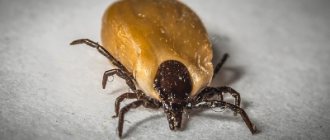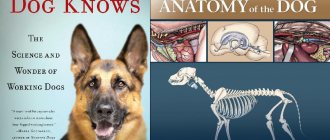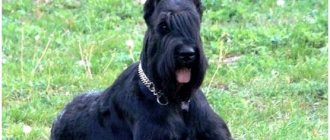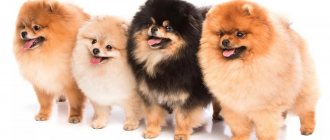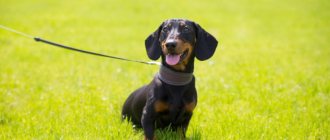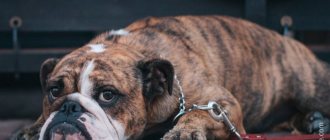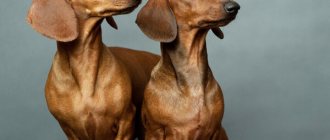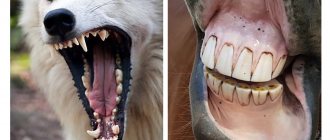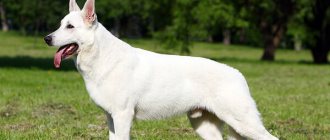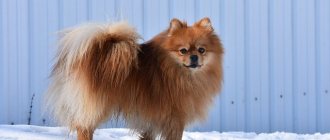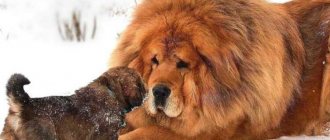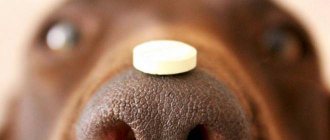The Golden Retriever dog is the kindest, most flexible and intelligent dog. She will become your children's best friend as she is not aggressive. He behaves friendly with strangers.
If you decide to buy a puppy of this breed, then you have acquired a friend and companion for life.
This “sunny” dog belongs to large hunting breeds. She is suitable for the role of a rescuer, a guide, a hunter and a nanny for your children.
Features of retrievers
Retrievers are different.
It’s worth remembering right away that a retriever is a hunting dog. Initially, they were bred as helpers, capable of bringing wounded or killed prey intact. Therefore, breeders and breeders highly valued the soft jaw, good-natured nature and keen sense of smell.
Thanks to this, the dog did not tear prey, like some other hunting dogs, and could easily find it even in thick grass or water.
Fact! Today, the retriever sections include six dog breeds.
History of the origin of the variety
The oldest variety of retriever is the golden retriever. It was developed back in the mid-nineteenth century. Experts believe that the direct ancestors of the breed were the Newfoundland, Irish Setter, Bloodhound, Water Spaniel and the Tweed Water Spaniel, which no longer exists today. Such an explosive mixture made it possible to develop a truly successful breed.
It is believed that one day a dog connoisseur, Lord Tweedmouth, watched dogs in a circus in 1858. He was so impressed by their intelligence that he without hesitation acquired eight individuals, which laid the foundation for the popular breed.
Subsequently, other types of retrievers were bred in different countries. They had a certain specialization and were valued by hunters who preferred different prey. But it is the large hunting golden retriever that is most popular throughout the world.
Advantages and disadvantages
The main advantages of golden retrievers:
- Excellent character;
- Lack of aggression;
- High level of intelligence;
- Love for children;
- Ability to learn.
Flaws:
- Dog fur is a strong allergen;
- They are very trusting, and therefore it is impossible to grow them into guards;
- High price.
The Golden Retriever is an ideal dog for a large family, whose appearance will bring joy, comfort and happiness into the home. Adults will find a faithful friend, and little children will find an affectionate and caring nanny.
Golden or golden
The Golden Retriever is the most common
. Of course, even if you go through all the breeds in the section, this particular one is one of the most beautiful.
The Golden Retriever's build is simply superb - harmonious, with round, muscular and strong paws.
- The head is graceful, proportional to the body.
- In the dark brown eyes one can read a sharp intelligence and almost always a little sadness. The eyes are set wide apart, the eyelids have dark edges.
- The ears are hanging, medium in size, located at approximately the same level as the eyes.
- The neck is long and very muscular.
- The chest is wide, which allows you to run for a long time without fatigue.
- The long tail does not bend.
The coat can be either wavy or straight (more on this below). The undercoat is thick, thanks to which it retains water and temperature well - the dog does not feel discomfort, even if it is forced to dive into icy water in winter and then be in the cold for some time.
Interesting! The breed was included in the FCI breed list in 1954.
The color can be different, the main thing is that it is not white - this color is a breeding defect and such puppies will be immediately disqualified.
These English retrievers are quite large and strong - the height at the withers ranges from 51 to 61 cm, and the weight ranges from 25 to 41 kg. At the same time, males are much taller and heavier than females.
Curly-coated (curly-coated)
In general, it was the Curley that officially appeared before the Golden - according to some sources, back in the sixteenth century. However, dogs of that time did not fit modern standards at all.
Curley was the result of crossing a Newfoundland and an Irish Water Spaniel. But already at the end of the nineteenth century, poodle blood was added, which changed the appearance of the dogs and also improved the quality of the coat.
Curley is the largest among retrievers - the height of females is about 62 cm, and males - 68 cm.
How to choose a puppy video
There are several unspoken rules that are recommended to be followed when buying a pet:
- The place where the puppies are kept must be clean and well-groomed.
- Inform the seller about the purpose of the purchase - it is important to know whether the dog is being purchased for exhibitions or for home keeping.
- Appearance of the puppy: the eyes should be clear, the head should be wide and large. The mouth should have several incisors, fangs and side teeth. There are no unpleasant odors or discharge - the puppy is completely healthy.
It is also necessary to pay attention to the retriever's pedigree, especially if the pet will participate in exhibitions. Pedigree affects the final cost of the puppy.
Labrador
Different colors are acceptable for Labradors.
Often, beginners want to know everything about the types of Labradors. And this is the wrong way to pose the question - in fact, there is only one breed - the Labrador Retriever. Therefore, the question of what types of Labradors there are is very incorrect.
It was developed in Canada in the nineteenth century. Breeders mixed several dog breeds at once - a small Newfoundland, a setter, a curly-haired retriever and an English foxhound. As a result of this mixture, the Labrador appeared - a type of retriever breed.
For reference! The standard was established at the end of the nineteenth century, namely in 1887.
Initially, this American dog had a strict color restriction. The Labrador's coat had to be black. But over time, fawn and then chocolate colors were also allowed. But, of course, these are not separate varieties of Labradors, but simply different colors of one.
Labradors are relatively small in size - males are about 56-57 cm tall and weigh 29-36 kg, while females are smaller - about 54-56 cm and 25-32 kg.
Character traits
The Golden Retriever got its name not only because of the color of its coat, but also because of its golden character. This dog will amaze you more than once with its temperament. The main character traits include:
Playfulness, curiosity. The dog is quite inquisitive, exploring and playing with everything that attracts its attention.
Friendliness. He is friendly towards children, his owner and even strangers. Retrievers are not guard dogs, as they are very kind and sweet even with strangers.
Courage, determination. Reacts quickly if a person is in danger, and despite the difficulty of the situation, tries to help to the end.Compliance, obedience. “Goldie” is a very submissive dog, happily follows various commands, loves the attention of the owner.
The most popular dog names in alphabetical order with recommendationsShar Pei - history of the breed, character traits, care and possible problems + 87 photos
American Bulldog - history of the breed, appearance, specifics and characteristics, care (100 photos + video)
High intelligence. They are easy to train, according to the owner’s intonation, they understand commands.
Golden Retriever puppies are known to be disobedient, but with a conscientious owner, they will readily follow orders. An excess of energy and unused activity will lead to negative consequences, namely damage to furniture.
A well-trained retriever is a very intelligent and balanced dog that is friendly towards children and other animals.
This breed is not characterized by aggression, so they make good caregivers for small children.
Nova Scotian (toller)
Compact dog lovers will love this Canadian native. The breed is the youngest in the section - bred in the mid-twentieth century, and the standard was only recognized in 1987. From the name it is clear that it was used during hunting to attract birds (or rather, distract their attention).
Compared to other breeds, this retriever is small - its height is no more than 51 cm, and more often less. In recent years, the breed has gained considerable popularity in many European countries, especially in Scandinavia.
It is used not only as a hunting assistant, but also as a companion, and thanks to its particularly sharp mind, it is perfect for participating in various competitions.
Diet
Meats include lamb, beef, turkey, and rabbit. Pork and poultry bones are not allowed. It is advisable to add pumpkin, carrots, cabbage, beets with herbs, and buckwheat to the food. By-products are possible in small quantities.
Adult dogs need two meals a day and fermented milk products; puppies are fed more often, always including milk in the menu. Feeding occurs only after walking. You can use premium dry products.
Straight-haired
Like many of the best dog breeds, it was bred in Great Britain. It combines the genes of a Labrador Retriever, an English Pointer and an Irish Setter. Thanks to this, the dog swims superbly, has excellent sense of smell and works well on the hunt.
Curious! The second name of the breed is smooth-haired retriever or flat.
Compared to other representatives of the section, this type seems more lanky. With the height of males 59-62 cm at the withers and females 56-59, they weigh about 27-36 and 25-32 kg, respectively.
The dog gained particular fame during the First World War - it was actively used for various official purposes, from searching for mines to detaining spies. However, in recent years they can also often be seen as guide dogs, companion dogs, and also in tracking work.
Caring for an adult dog
Caring for an adult dog of this breed is not difficult, but it must be constant and comprehensive:
- The diet is developed in accordance with the age of the dog; preference should be given to food that is high in calories and concentrated.
- Eye care involves washing them regularly, especially after hunting. The eyes should be clean, without purulent discharge. If pus appears or the dog’s eyes are watery, then this is a signal about his illness.
- The ears are cleaned once a week, rinsing them with a 10% hydrogen peroxide solution and cleaning them with a soft swab.
- It is recommended to periodically brush your teeth with a special paste and brush. To prevent tartar from appearing and to keep teeth and gums healthy, solid foods are included in the diet: carrots, apples, crackers or biscuits, etc.
- It is advisable to comb the coat daily, and bathe it no more than 1-2 times a month with a special shampoo. After bathing, the dog is thoroughly dried to avoid colds.
- Every day after walks, inspect your pet’s paws for stuck foreign objects, as well as his skin for ticks and other parasites.
- You need to walk your dog for at least 2 hours every day, give it active physical activity, making it run and jump.
- Once a year - a routine examination by a veterinarian.
Chesapeake Bay Retriever
Gorgeous Virginian
Sometimes you can hear the opinion that the Chesapeake Bay is a German retriever. In fact, this is not so, the breed was bred in the USA.
The breed's homeland is the glorious state of Virginia, whose shores are washed by the Chesapeake Bay. The abundance of ducks in this area means that water fowl dogs are in high demand. Of course, local breeders did everything possible to get their own dog.
By the way, the Chesapeake Bay is perfect for swimming in icy water - its ears are short, thick and set higher than those of other retrievers. And the wool is thick, coarse, and almost impermeable to water.
Interesting! In 1964, the Chesapeake Bay became the official symbol of the State of Maryland.
The height and weight of males are about 58-66 cm and 30-37 kg, and females are 53-61 cm and 25-32 kg, respectively. Pronounced webbing is visible on the fingers.
Differences in retrievers by color
Of course, all types of retrievers are similar breeds. But they still have certain differences. To begin with, the colors allowed here are very diverse. What is standard for one breed will be a waste for another.
For example, a Labrador can be black, roan, or chocolate. But for goldens, only golden or cream color is acceptable.
Chesapeake Bay is very different - the color of withered grass is most valued, but any shades from light straw to dark brown are not considered rejects.
Differences between retrievers by coat type
For most varieties of retrievers, the standard provides for a special coat length - about 5 cm. Too short or long can be considered defective. So, many breeders who are interested in what the long-haired Labrador is called will be disappointed - regardless of the name, it is a defect.
But there are certain exceptions to the rules. For example, the Flat-Coated Retriever has a dense, smooth coat that feels silky to the touch.
The curly-coated retriever is even more different. It has no undercoat at all, and the coat is very short and thick. It is collected in dense curls that adhere quite tightly to the skin.
